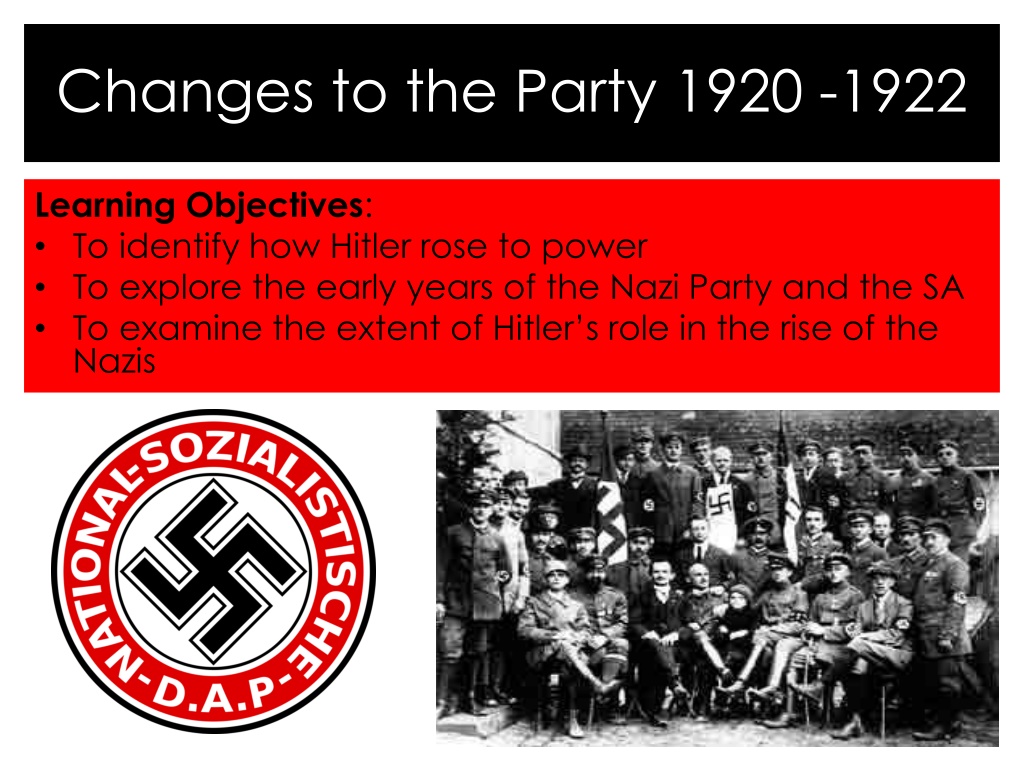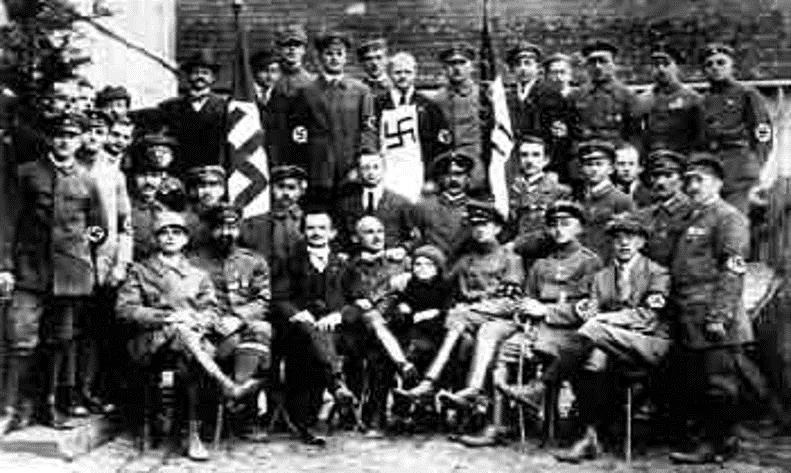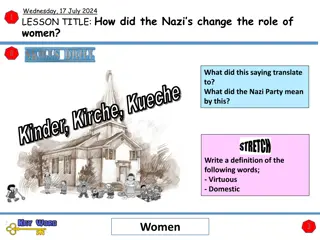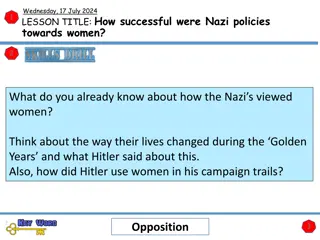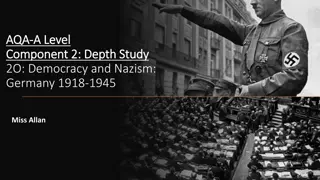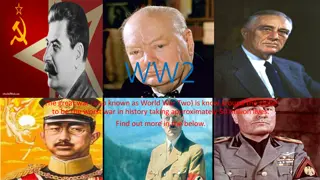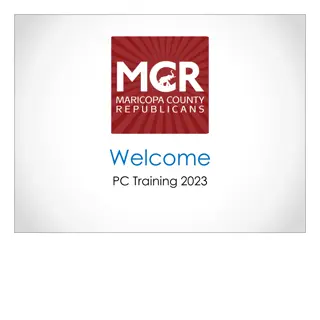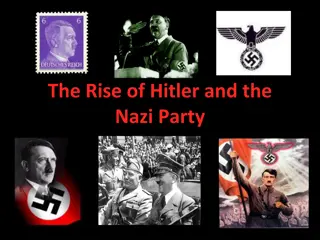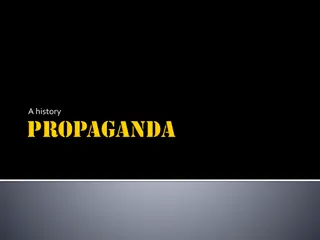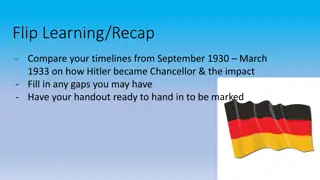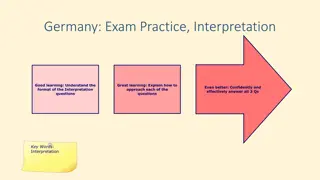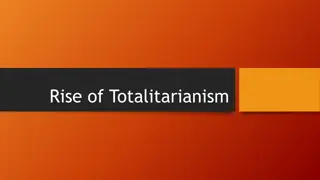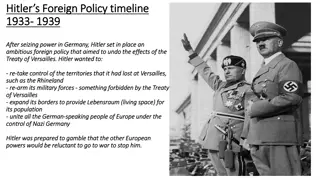The Rise of Hitler and the Changes in the Nazi Party 1920-1922
Explore how Adolf Hitler ascended to power and examine the significant developments within the Nazi Party between 1920 and 1922, including Hitler's role, the creation of the SA, the 25 Point Programme, Hitler's leadership, and the use of propaganda and violence.
Download Presentation

Please find below an Image/Link to download the presentation.
The content on the website is provided AS IS for your information and personal use only. It may not be sold, licensed, or shared on other websites without obtaining consent from the author. Download presentation by click this link. If you encounter any issues during the download, it is possible that the publisher has removed the file from their server.
E N D
Presentation Transcript
Changes to the Party 1920 -1922 Learning Objectives: To identify how Hitler rose to power To explore the early years of the Nazi Party and the SA To examine the extent of Hitler s role in the rise of the Nazis
Changes to the Party 1920 -1922 LO: To identify how Hitler rose to power Use the information on the next few pages to build a timeline of the development and changes in the Nazi Party between 1919 and 1922. This can be added to your existing timeline that you have already created. In 1919 Anton Drexler created the DAP (German Worker s Party) in Munich, Bavaria. The party believed in a pure German people and were very nationalistic (patriotic). In 1919 they only had 6 members.
Changes to the Party 1920 -1922 LO: To identify how Hitler rose to power In September 1919 Adolf Hitler attended a meeting and was so angry at one of the speaker s comments he made a powerful speech in reply. Drexler was so impressed with his speaking skills that he asked Hitler to join the party. In the DAP Hitler realised he was talented at public speaking and was soon put in charge of recruitment and propaganda.
Changes to the Party 1920 -1922 LO: To identify how Hitler rose to power In February 1920 Hitler and the then leader of the party Anton Drexler wrote the 25 Point Programme. A political manifesto of the party s (then known as the DAP) ideas. Hitler kept to these ideas most of his life. These ideas included all non Germans having to leave and scrapping the Treaty of Versailles. Many of the ideas were anti-Semitic (anti Jewish). In 1920 the party grew massively (largely thanks to Hitler s public speaking skills) and became known as the Nazi Party. The increased membership to the party meant that they could publish their own newspaper (The People s Observer) where they could advertise their ideas.
Changes to the Party 1920 -1922 LO: To identify how Hitler rose to power In 1921 Hitler became leader of the party. He had the role of Fuhrer (leader) and developed Fuhrerprizip which meant he had absolute power in the party and was answerable to none. This was a warning of how he planned to rule Germany in the future. In 1921 Hitler also started to use the swastika as the symbol of the Nazi Party and the one armed salute. The Sturmabteilung (SA) were also created and led by Ernst Rohm in 1921 to protect Nazi speakers. They were bully boy thugs and used violence. They were known as the brown shirts because of the colour of their uniform.
Changes to the Party 1920 -1922 LO: To identify how Hitler rose to power Hitler used the SA to disrupt meetings of his opposition parties (the Communists and the Social Democrats). His speeches criticised the Weimar Government (the November Criminals) and their mistakes (the Treaty of Versailles) but also contained hate for Jews and emphasis on the purity of the German race (an need for an Aryan race). He used the Jews as a scapegoat for all of Germany s problems. He used lots of publicity and membership of the party grew to 55,000. However, the majority of his support was in the area of Bavaria. Choose two events in Hitler s life so far that you would regard as turning points. Explain why each event you have chosen was so important.
Changes to the Party 1920 -1922 LO: To explore the early years of the Nazi Party and the SA Sturmabteilung (SA) or storm troopers They were the Nazis private army They were recruited from demobbed soldiers, the unemployed & students These Brownshirts provided security at meetings & bodyguards for Nazi leaders They broke up meetings of opposition groups Hitler put Rohm in charge of the SA Many of the SA were thugs & difficult to control so in 1923 Hitler selected trusted members of the SA & formed his own personal bodyguard the Stosstrupp or Shock Troop Explain the role of the SA in Hitler s Nazi Party?
Changes to the Party 1920 -1922 LO: To explore the early years of the Nazi Party and the SA What do you learn about the SA (Stormtroopers) from the below source? Source 1 The trouble had not begun when my storm troopers attacked. Like wolves, they flung themselves in packs of eight or ten upon the enemy. After only five minutes, I hardly saw one of them who was not covered in blood. The hall looked as if a shell had struck it. Many of my supporters were being bandaged, others had to be driven away, but we had remained the masters of the situation. Adolf Hitler, 1925
Changes to the Party 1920 -1922 LO: To examine the extent of Hitler s role in the rise of the Nazis There were four main ways in which Hitler was able to rise to power. The creation of the SA The designing of the Nazi Emblem Hitler s own charisma Hitler gathering close supporters You have already learnt about the role of the SA. Now read the next slides. In your pairs, discuss how all these factor helped Hitler rise to power. Make bullet point notes as you go.
Changes to the Party 1920 -1922 LO: To examine the extent of Hitler s role in the rise of the Nazis Nazi Emblem As a self-proclaimed artist, Hitler gave a lot of thought to the Nazi symbology. He recognised the need for the Nazis to have a memorable emblem, and designed the now infamous flag. The colours of the flag red, black and white were the same colours as the flag under the Kaiser Red represented the socialist ideas of the movement, white the nationalist and the swastika the mission for the victory of the Aryan man The flag and swastika emblem essentially turned the Nazis from a political party into a household brand. As a result, Hitler propelled the party in the popularity stakes, and membership rose quickly.
Changes to the Party 1920 -1922 LO: To examine the extent of Hitler s role in the rise of the Nazis Charisma Hitler was incredibly charismatic. He was also an excellent orator (public speaker) and drew huge crowds to his Nazi speeches and rallies. This increased the Nazi audience, and allowed them to convey their ideas to the masses. No other party at the time had such a hypnotic speaker. As a result, support for the party greatly increased.
Changes to the Party 1920 -1922 LO: To examine the extent of Hitler s role in the rise of the Nazis Close Supporters As soon as Hitler took the leadership in 1921, he surrounded himself with loyal supporters. He rewarded these men with positions of power in the party, and many went on to become top Nazis in later years. By surrounding himself with these supporters, he ensured his own position was safe, whilst being able to delegate most of his dirty work to them. This created competition within the Nazi party itself, with several prominent supporters vying for power, which essentially caused the party to escalate its policies and become more and more extreme.
Changes to the Party 1920 -1922 LO: To identify how Hitler rose to power Review Source 5 on pgs. 34-35 in your text books. Using your own knowledge and Source 5 create a spider diagram that outlines what the Nazi s stood for and the aims of the party.
